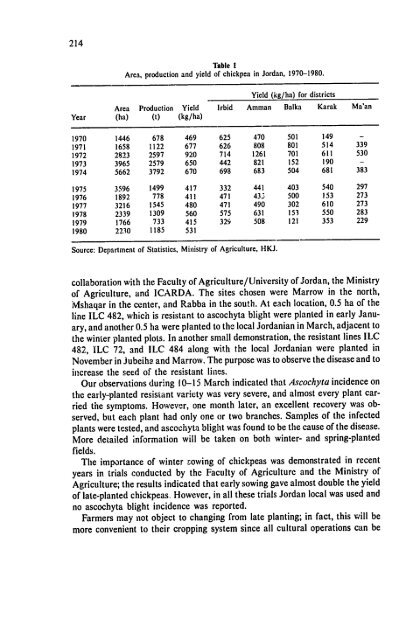I - --ii
I - --ii
I - --ii
Create successful ePaper yourself
Turn your PDF publications into a flip-book with our unique Google optimized e-Paper software.
214<br />
Table I<br />
Area, production and yield of chickpea in Jordan, 1970-1980.<br />
Yield (kg/ha) for districts<br />
Area Production Yield Irbid Amman Balka Karak Ma'an<br />
Year (ha) (t) (kg/ha)<br />
1970 1446 678 469 625 470 501 149 -<br />
1971 1658 1122 677 626 808 801 514 339<br />
1972 2823 2597 920 714 1261 701 611 530<br />
1973 3965 2579 650 442 821 152 190 -<br />
1974 5662 3792 670 698 683 504 681 383<br />
1975 3596 1499 417 332 441 403 540 297<br />
1976 1892 778 411 471 43.3 500 153 273<br />
1977 3216 1545 480 471 490 302 610 273<br />
1978 2339 1309 560 575 631 153 550 283<br />
1979 1766 733 415 329 508 121 353 229<br />
1980 2230 1185 531<br />
Source: Department of Statistics, Ministry of Agriculture, HKJ.<br />
collaboration with the Faculty of Agriculture/University of Jordan, the Ministry<br />
of Agriculture, and ICARDA. The sites chosen were Marrow in the north,<br />
Mshaqar in the center, and Rabba in the south. At each location, 0.5 ha of the<br />
line ILC 482, which is resistant to ascochyta blight were planted in early January,<br />
and another 0.5 ha were planted to the local Jordanian in March, adjacent to<br />
the winter planted plots. In another small demonstration, the resistant lines ILC<br />
482, ILC 72, and ILC 484 along with the local Jordanian were planted in<br />
November in Jubeiha and Marrow. The purpose was to observe the disease and to<br />
increase the seed of the resistant lines.<br />
Our observations during 10-15 March indicated that Ascochyta incidence on<br />
the early-planted resistant variety was very severe, and almost every plant carried<br />
the symptoms. However, one month later, an excellent recovery was observed,<br />
but each plant had only one or two branches. Samples of the infected<br />
plants were tested, and ascochyta blight was found to be the cause of the disease.<br />
More detailed information will be taken on both winter- and spring-planted<br />
fields.<br />
The importance of winter sowing of chickpeas was demonstrated in recent<br />
years in trials conducted by the Faculty of Agriculture and the Ministry of<br />
Agriculture; the results indicated that early sowing gave almost double the yield<br />
of late-planted chickpeas. However, in all these trials Jordan local was used and<br />
no ascochyta blight incidence was reported.<br />
Farmers may not object to changing from late planting; in fact, this will be<br />
more convenient to their cropping system since all cultural operations can be

















